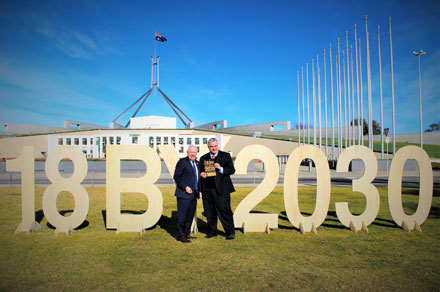
Australia’s forestry sector could reduce the Federal Government’s 2030 greenhouse emissions target by almost a quarter if the right policies are put in place, according to an industry body. By Philip Hopkins for Timberbiz
Forestry could take 18 million tonnes (megatonnes) of greenhouse gas emissions from the atmosphere by 2030 – 23% of the 79 million tonnes that must be reduced if the targeted is to be reached, says the Australian Forest Products Association.
AFPA chairman, Greg McCormack, said the sector would then cut at least 18 million tonnes of GHG emissions every year from 2030 onwards.
Australia’s climate change target is to reduce emission levels in 2005 – 612 million tonnes of carbon dioxide equivalent – by 26-28% to 453 Mt CO2-e by 2030. Annual emissions in 2017 were 532 Mt CO2-e. This is 79 million tonnes short of the target.
Mr McCormack said the increasing amount of carbon stored would mainly be due to growing new plantations – the most important of six possible sequestration options.
These are:
- Storing carbon in 400,000 hectares of new plantations.
- Replanting existing forest plantations to maximise ongoing carbon storage.
- Increasing use of wood in new houses, multi-rise apartments and commercial buildings to offset emissions.
- Using more bioenergy (both electricity and renewable heat) in industry.
- Using more biofuels for transport.
- Using more sustainably sourced biomass in power stations.
The intellectual underpinning of the AFPA’s policy is based on the 4th assessment report of the International Panel on Climate Change (IPCC).
This states:
“A sustainable forest management strategy aimed at maintaining or increasing forest carbon stocks, while producing an annual sustained yield of timber, fibre or energy from the forest, will generate the largest sustained (carbon) mitigation benefit.”
The new plantation carbon storage figures are based on a June 2018 report by BAEconomics, “Carbon sequestration potential of plantation forestry expansion in Australia”. Written by Brian Fisher and Anna Matysek, it was commissioned by Forest & Wood Products Australia.
The Federal Government is due to release a forestry industry policy later this year, and the Labor Opposition has pledged to make new plantations part of its carbon abatement policy.
Mr McCormack said the 18 megatonnes of CO2-e equated to the annual emissions reductions from about 4200 modern wind turbines, or offsetting more than three million cars’ worth of emissions running on fossil fuels for a year.
“We (forestry) replant and regenerate every thing we harvest. Every year, our industry alone replants more than 70 million trees. All forest products from paper to house framing timber are recyclable and renewable,” he said. “Our sector is one of the few which can claim to be on the right side of the climate change ledger.”
The AFPA’s policy notes that Australia’s forest plantation estate already stores 171 megatonnes of carbon. This equates to 628 megatonnes of CO2 equivalent, based on the conversion factor of 3.664 used in Australia’s National Greenhouse accounts.
Mr McCormack said even more carbon storage was available in other ways. These included:
- Counting the additional carbon stored in below-ground biomass, such as roots of new plantations.
- Enhanced management of sustainable native forests to maximise the ongoing storage of carbon.
The ABARES publication, ‘Australian forests at a glance 2017’, shows that production native forests contain 2057 million tonnes of carbon, while non-production native forests have 10,613 million tonnes of carbon.
Harvested wood products in service store 103 million tonnes of carbon while wood products in landfill store 123 million tonnes of carbon.





